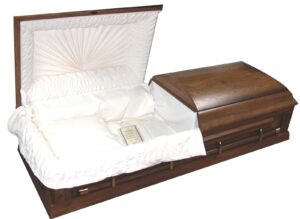 “I’ll Just Remember Them the Way They Were:” The Importance of Educating Families About Keeping the “Guest of Honor” Around for the Funeral
“I’ll Just Remember Them the Way They Were:” The Importance of Educating Families About Keeping the “Guest of Honor” Around for the Funeral
I frequently have people say to me, “I’ll just remember them the way they were.” Of course, those of us in death care should not be surprised by this reflection: After all, many people have never been taught WHY to consider keeping the body that animated life present before and during the funeral.
As people question the value of funerals, part of your gatekeeper role is theme everything you do with information, education, and choices. Why? Because a general trend we have witnessed is that for a substantial number of people the presence of the body at the funeral has become not only optional, but even undesirable.
The purpose of this article is to review some of the historical wisdom surrounding the function of the dead body being present during the funeral. In addition, I hope the content helps you enhance your capacity to educate families when questions come up related to this important topic.
As you know, the initial funeral element is that of the visitation, historically called a “wake” or “viewing.” The term “wake” comes from the Middle English waken meaning “to be awake” and “to keep watch.” It was often customary for the family and primary mourners to keep around-the-clock vigil over the dead body. The body was kept in their home, often on display in an open casket in the parlor. Mourners took turns sitting with the body, 24 hours a day, to offer prayers, pay their respects, receive friends, and comfort one another. Essentially, they were, in part, saying hello on the path to goodbye.
But in these days gone by, the guest of honor wasn’t just present at the visitation. The body was the focal point of the entire funeral process, from the procession into the church to the procession out of the church to the procession to the cemetery through to the committal. The body never left the family’s sight – or heart.
Yet in recent decades, the trend has been toward body-absent ceremonies, which can seem more like parties than authentic funeral experiences. Historically we understood the essential, universal need to honor and affirm the life of the person who died with the body present throughout the entire funeral process. Now the guest of honor is often missing.
We seem to be forgetting what many have known since the beginning of time. Throughout human history, clans and tribes revered and stayed present to the body until it was laid to final rest. In fact, cultures the world over have demonstrated a passion to recover the “fallen warrior” and dignify the death by bringing home the body.
Of course, it is important to note that we should always be respectful of exceptions. For example, not all faith communities find it appropriate to spend time with the body. For example, in Judaism families sit Shiva without the presence of the person who died. In addition, there are times when the body has been traumatized and an “appropriate memory picture” is not available
to be viewed. In situations such as this, other steps can be taken to help families with the lynchpin need of mourning – acknowledging the reality of the death. Obviously, this is one of the main functions that having the body present serves.
Have you ever heard people say, “Well, it’s just a shell?” In my experience this is often an attempt to render the body irrelevant and make it disposable. Regardless of your faith (or lack thereof) in the soul and the afterlife, the body of the person who died is still precious. The body still very much represents the person you love. This is the body that animated life! Doesn’t this person deserve to be accompanied or seen through to the end of their days on Earth, which includes the disposition of their body?
Of course, I don’t need to tell you that a dead body is not the same as the person we loved. No matter your spiritual beliefs, it is clear to anyone who spends any time at all with the dead body of someone they cared about that the soul no longer resides there. But when we are grieving, the mind seeks proof. So, if we are fortunate, we see the body, we touch the body, we spend time with the body… and our minds, which so very much want to deny the truth, cannot help but begin to the process of acknowledging the reality of the death.
Bereavement originates from the word “reave,” meaning “to be deprived of” or “to be forcibly robbed of something.” When we experience the death of someone loved, we are indeed forcibly robbed of something very precious to us. But for a short time – a few hours or days after the death – we have the opportunity to still be with the person who died, in the form of the dead body, even as we have no choice but to begin to take leave of them. So, not only is the dead body “proof” for our logical mind, but it is also a means of transition for our searching heart, which so much yearns to still be with the person. It can – in a way that can feel uncomfortable and painful in the moment but is ultimately helpful and healing.
And what of the common objection, “I don’t want to remember them that way?” My experience suggests that the image of the person in death does not become the lasting image in the mind of the survivor. While the sight and presence of the dead body meets the cognitive need to verify the death, that very image usually fades and it is the living memories that are everlasting.
I’ll never forget the 102-year-old woman who entered a funeral home to attend a friend’s funeral. The funeral director was greeting guests as she arrived. The elderly woman took his arm and said, “I’ve never been to one of these before!”
The funeral director was quite surprised. Was it even possible that a centenarian had never attended a funeral? So, he asked, “This is the first funeral you’ve been to?”
“No,” she chastised. “Of course I have been to funerals. But I’ve never been to one where the person who died wasn’t there. Where the hell is he? Does he have something better to do than be at his own funeral?”
My hope is that the next time a family says, “I’ll just remember him the way he was” or “It’s just a shell,” you will reflect on this article and help them better understand the value of having the body present – open-casketed, closed-casketed, or in the form of cremated remains – throughout the funeral process. Remember – a meaningful funeral is not about denying death but befriending it. Let’s not dispatch with bodies. Let’s treat them with the reverence and respect they deserve. Perhaps most of all, let’s remember the value of the need to say hello on the pathway to goodbye.
AFTERTALK is a non-profit organization that depends on contributions to survive and thrive. We urge you to donate whatever you feel appropriate. Just click on the blue DONATE button near the top of our Facebook page at this link: https://www.facebook.com/griefandloss
Thank you for your support.
CLICK HERE TO JOIN AFTERTALK
Free, Non-Profit and Non-denominational
We invite you to submit your thoughts, essays, poems or songs. Please send to info@aftertalk.com. To see past AfterTalk Weeklies, CLICK HERE

Oh – so very difficult it is for many of us to try to escape briefly the reality of loss that stares us right back in the face . . . and recently when this reality looked me right back into the face at my wife’s funeral, burial and Shiva Service – I readily joined into the conversant path away from her (AND MY) new reality. There are several directions upon review for me to take such as:- 1) See this as a brief away from under the over realm of horror I am in; 2) See this as a continuing way to cope with the untouchable pain; 3) Shrink in horror with guilt and seek medication; 4) Seek some combination – possibly in consultation based on degree of upset.